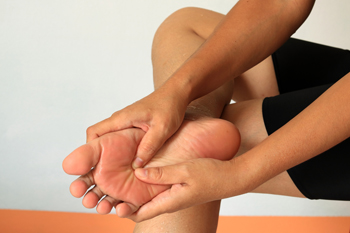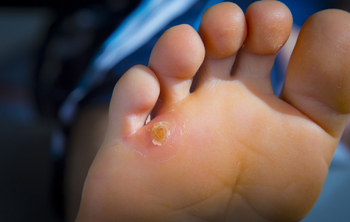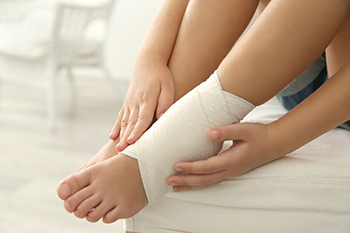Connect With Us
Blog
Items filtered by date: December 2023
Nerve Pain in the Feet

Nerve pain in the feet, manifesting as a burning, tingling, or electric shock-like sensation, can be debilitating and impede daily activities. It can emerge at night or during specific actions, often linked to conditions like Morton’s neuroma, which causes thickened tissue around nerves. It may also be indicative of tarsal tunnel syndrome, where nerve compression triggers sharp, shooting pains. Diabetic neuropathy begins with pain in the toes that can expand upwards. Causes for these nerve issues vary, including factors like wearing ill-fitting shoes, physical injuries, and systemic health issues like diabetes, obesity, or infections. Treatment strategies depend on the underlying cause. If you have nerve pain in your feet, it is suggested that you make an appointment with a podiatrist to obtain a diagnosis and treatment. This can help prevent the progression of potential conditions and enhance your quality of life.
Neuropathy
Neuropathy can be a potentially serious condition, especially if it is left undiagnosed. If you have any concerns that you may be experiencing nerve loss in your feet, consult with James Torhorst, DPM from Torhorst Foot and Ankle. Our doctor will assess your condition and provide you with quality foot and ankle treatment for neuropathy.
What Is Neuropathy?
Neuropathy is a condition that leads to damage to the nerves in the body. Peripheral neuropathy, or neuropathy that affects your peripheral nervous system, usually occurs in the feet. Neuropathy can be triggered by a number of different causes. Such causes include diabetes, infections, cancers, disorders, and toxic substances.
Symptoms of Neuropathy Include:
- Numbness
- Sensation loss
- Prickling and tingling sensations
- Throbbing, freezing, burning pains
- Muscle weakness
Those with diabetes are at serious risk due to being unable to feel an ulcer on their feet. Diabetics usually also suffer from poor blood circulation. This can lead to the wound not healing, infections occurring, and the limb may have to be amputated.
Treatment
To treat neuropathy in the foot, podiatrists will first diagnose the cause of the neuropathy. Figuring out the underlying cause of the neuropathy will allow the podiatrist to prescribe the best treatment, whether it be caused by diabetes, toxic substance exposure, infection, etc. If the nerve has not died, then it’s possible that sensation may be able to return to the foot.
Pain medication may be issued for pain. Electrical nerve stimulation can be used to stimulate nerves. If the neuropathy is caused from pressure on the nerves, then surgery may be necessary.
If you have any questions, please feel free to contact our offices located in Waupaca and Stevens Point, WI . We offer the newest diagnostic and treatment technologies for all your foot care needs.
Reminder: When Was the Last Time...?
Causes of Foot Corns

A foot corn, medically known as a heloma, is a common foot condition characterized by a localized thickening of the skin that usually occurs on the feet or toes. These corns are typically small, circular, or conical in shape, and may have a central core of hard, dense material. The two primary types of foot corns are hard corns and soft corns. Hard corns often form on the tops or sides of toes and the balls of the feet, appearing as yellow or gray, dense patches of skin. Soft corns tend to develop between the toes in moist, sweaty areas, having a softer, more rubbery texture. The main cause of foot corns is persistent friction and pressure on the skin, often due to wearing ill-fitting shoes, high heels, toe deformities, walking abnormalities, or excessive moisture exposure. If corns develop on your feet and become painful, it is suggested that you schedule an appointment with a podiatrist who can recommend appropriate treatments and measures for relief. These may include wearing protective pads, cushioning, orthotics, or, in some cases, professional corn removal.
If you have any concerns regarding your feet and ankles, contact James Torhorst, DPM of Torhorst Foot and Ankle. Our doctor will treat your foot and ankle needs.
Corns: What Are They? and How Do You Get Rid of Them?
Corns can be described as areas of the skin that have thickened to the point of becoming painful or irritating. They are often layers and layers of the skin that have become dry and rough, and are normally smaller than calluses.
Ways to Prevent Corns
There are many ways to get rid of painful corns such as wearing:
- Well-fitting socks
- Comfortable shoes that are not tight around your foot
- Shoes that offer support
Treating Corns
Treatment of corns involves removing the dead skin that has built up in the specific area of the foot. Consult with Our doctor to determine the best treatment option for your case of corns.
If you have any questions please feel free to contact our offices located in Waupaca and Stevens Point, WI . We offer the newest diagnostic and treatment technologies for all your foot and ankle needs.
Types of Ankle Sprains

Ankle sprains, a common injury, can be classified into three types based on the affected area and ligament. Lateral sprains are the most frequent, occurring when the foot rolls outward, impacting the outer ankle ligaments. Medial sprains are less common, caused by the foot rolling inward and straining the inner ankle ligaments. High ankle sprains, though less frequent, are more severe, affecting the ligaments above the ankle joint, especially during activities where the tibia and fibula are forced apart. Each type of sprain varies in symptoms and severity, and their treatment can range from rest to surgery, in severe serious cases. If you have sprained your ankle, it is suggested that you schedule an appointment with a podiatrist for a diagnosis of which type of sprain has occurred, and appropriate treatment.
Ankle pain can be caused by a number of problems and may be potentially serious. If you have ankle pain, consult with James Torhorst, DPM from Torhorst Foot and Ankle. Our doctor will assess your condition and provide you with quality foot and ankle treatment.
Ankle pain is any condition that causes pain in the ankle. Due to the fact that the ankle consists of tendons, muscles, bones, and ligaments, ankle pain can come from a number of different conditions.
Causes
The most common causes of ankle pain include:
- Types of arthritis (rheumatoid, osteoarthritis, and gout)
- Ankle sprains
- Broken ankles
- Achilles tendinitis
- Achilles tendon rupture
- Stress fractures
- Bursitis
- Tarsal tunnel syndrome
- Plantar fasciitis
Symptoms
Symptoms of ankle injury vary based upon the condition. Pain may include general pain and discomfort, swelling, aching, redness, bruising, burning or stabbing sensations, and/or loss of sensation.
Diagnosis
Due to the wide variety of potential causes of ankle pain, podiatrists will utilize a number of different methods to properly diagnose ankle pain. This can include asking for personal and family medical histories and of any recent injuries. Further diagnosis may include sensation tests, a physical examination, and potentially x-rays or other imaging tests.
Treatment
Just as the range of causes varies widely, so do treatments. Some more common treatments are rest, ice packs, keeping pressure off the foot, orthotics and braces, medication for inflammation and pain, and surgery.
If you have any questions, please feel free to contact our offices located in Waupaca and Stevens Point, WI . We offer the newest diagnostic and treatment technologies for all your foot care needs.
Managing Foot Pain During Pregnancy

Pregnancy, with its myriad changes, often brings about discomfort, and foot pain is a common concern for many expectant mothers. Fortunately, several strategies can help alleviate this discomfort. Opting for comfortable, supportive footwear is vital, as the body undergoes weight changes that can impact foot structure. Regularly elevating the feet, especially after extended periods of standing, can help to reduce swelling and promote better circulation. Gentle stretching exercises, such as ankle circles and toe flexes, can offer relief and maintain flexibility. Adequate hydration is essential to prevent water retention, a common contributor to foot swelling. Cold compresses or foot massages may provide soothing relief while maintaining a healthy weight. Engaging in low-impact exercises, like swimming, can alleviate pressure on the feet. Regular prenatal checkups ensure any underlying conditions that contribute to foot pain are addressed promptly. If you are experiencing foot pain during your pregnancy, it is suggested that you confer with a podiatrist who can offer you effective relief techniques.
Pregnant women with swollen feet can be treated with a variety of different methods that are readily available. For more information about other cures for swollen feet during pregnancy, consult with James Torhorst, DPM from Torhorst Foot and Ankle. Our doctor will attend to all of your foot and ankle needs.
What Foot Problems Can Arise During Pregnancy?
One problem that can occur is overpronation, which occurs when the arch of the foot flattens and tends to roll inward. This can cause pain and discomfort in your heels while you’re walking or even just standing up, trying to support your baby.
Another problem is edema, or swelling in the extremities. This often affects the feet during pregnancy but tends to occur in the later stages.
How Can I Keep My Feet Healthy During Pregnancy?
- Wearing orthotics can provide extra support for the feet and help distribute weight evenly
- Minimize the amount of time spent walking barefoot
- Wear shoes with good arch support
- Wear shoes that allow for good circulation to the feet
- Elevate feet if you experience swelling
- Massage your feet
- Get regular, light exercise, such as walking, to promote blood circulation to the feet
If you have any questions please feel free to contact our offices located in Waupaca and Stevens Point, WI . We offer the newest diagnostic and treatment technologies for all your foot and ankle needs.

